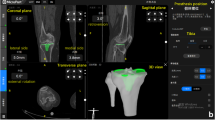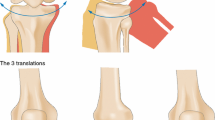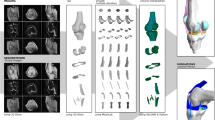Abstract
Total knee arthroplasty (TKA) has undergone significant evolution from the initial concept of ivory components to the integration of artificial intelligence. Modern technologies, such as computers and surgical robots, are now employed to precisely place implants and achieve a neutral joint configuration with minimal incisions. Despite these advancements, achieving the desired preoperative outcome remains a challenge. Accurate implant alignment continues to be a prominent limitation in the field. Malalignment results in unbalanced stresses, restricted range of motion, patient discomfort, and ultimately, TKA failure. This study reviews the limitations of commercially available TKA techniques, including navigated TKA, robotic-assisted TKA, and artificial intelligence-based approaches. Compared with the conventional TKA, navigated TKA offers the advantage of smaller incisions, but does not consistently achieve the planned implant position. Conversely, robotic-assisted surgery theoretically provides perfect neutral alignment, but its widespread use is hindered by high operational costs and associated complications. While machine learning can predict the outcomes, its current level of accuracy is not yet clinically acceptable. Although most of the calculations for Patient-specific implants are performed during preoperative session, reducing surgery duration, drawbacks include the added expense of CT scans and MRI images, while the promised results have yet to be consistently achieved.




Similar content being viewed by others
References
P.A. Dieppe, J. Cushnaghan, L. Shepstone, The Bristol ‘oa500’study: progression of osteoarthritis (OA) over 3 years and the relationship between clinical and radiographic changes at the knee joint. Osteoarth. Cartil. 5, 87–97 (1997)
L. Fraenkel, S.T. Bogardus, J. Concato, D.R. Wittink, Treatment options in knee osteoarthritis: the patient’s perspective. Arch. Intern. Med. 164, 1299–1304 (2004)
A.J. Carr, O. Robertsson, S. Graves, A.J. Price, N.K. Arden, A. Judge, D.J. Beard, Knee replacement. Lancet 379, 1331–1340 (2012). https://doi.org/10.1016/S0140-6736(11)60752-6
N. Eynon-Lewis, D. Ferry, M. Pearse, Themistocles gluck: an unrecognised genius. BMJ: Br. Med. J. 305, 1534 (1992)
R.P. Robinson, The early innovators of today’s resurfacing condylar knees. J. Arthroplasty 20, 2–26 (2005). https://doi.org/10.1016/j.arth.2004.11.002
F. Picard, E. Leitner, O. Raoult, D. Saragaglia, Computer assisted total knee arthroplasty. In:J. Jerosch, K. Nicol, K. Peikenkamp (eds) Steinkopff, Heidelberg, pp. 461–471 (1999)
F. Leitner, F. Picard, R. Minfelde, H.-J. Schulz, P. Cinquin, D. Saragaglia, Computer-assisted knee surgical total replacement. Springer, pp. 629–638 (1997)
M. Sohail, J.Y. Kim, H.S. Kim, Three-step femoral coordinate system for imageless total knee arthroplasty. In: Proceedings of Korean Soc. Mech. Eng (KSME) Annual Meeting, pp. 1681–1682 (2022)
H. Hoffart, E. Langenstein, N. Vasak, A prospective study comparing the functional outcome of computer-assisted and conventional total knee replacement. J. Bone Jt. Surg. Br. 94, 194–199 (2012)
B.P. Chalmers, D.A. Kolin, D.J. Mayman, T.M. Miller, S.A. Jerabek, S.B. Haas, M.P. Ast, Three degrees external to the posterior condylar axis has little relevance in femoral component rotation: a computed tomography-based total knee arthroplasty simulation study. J. Arthroplasty 36, S380–S385 (2021)
D. Saragaglia, B. Rubens-Duval, J. Gaillot, G. Lateur, R. Pailhé, Total knee arthroplasties from the origin to navigation: history, rationale indications. Int. Orthopaed. (SICOT) 43, 597–604 (2019). https://doi.org/10.1007/s00264-018-3913-z
R.S. Nizard, R. Porcher, P. Ravaud, E. Vangaver, D. Hannouche, P. Bizot, L. Sedel, Use of the cusum technique for evaluation of a CT-based navigation system for total knee replacement. Clin. Orthopaed. Relat. Res. 425, 180–188 (2004)
J. Stiehl, W. Konermann, R. Haaker, Navigation and robotics in total joint and spine surgery (Springer, Berlin, 2004)
J. Victor, D. Hoste, Image-based computer-assisted total knee arthroplasty leads to lower variability in coronal alignment. Clin. Orthopaed. Relat. Res.® 428, 131 (2004). https://doi.org/10.1097/01.blo.0000147710.69612.76
R.M. Tabatabaee, M.R. Rasouli, M.G. Maltenfort, R. Fuino, C. Restrepo, A. Oliashirazi, Computer-assisted total knee arthroplasty: is there a difference between image-based and imageless techniques? J. Arthroplasty 33, 1076–1081 (2018). https://doi.org/10.1016/j.arth.2017.11.030
L. Perlick, H. Bäthis, M. Tingart, C. Perlick, J. Grifka, Navigation in total-knee arthroplasty CT-based implantation compared with the conventional technique. Acta Orthop. Scand. 75, 464–470 (2004)
T. Heinz, A. Eidmann, P. Anderson, M. Weißenberger, A. Jakuscheit, M. Rudert, I. Stratos, Trends in computer-assisted surgery for total knee arthroplasty in Germany: an analysis based on the operative procedure classification system between 2010 to 2021. J. Clin. Med. 12, 549 (2023)
I. Bendich, M. Kapadia, K. Alpaugh, A. Diane, J. Vigdorchik, G. Westrich, Trends of utilization and 90-day complication rates for computer-assisted navigation and robotic assistance for total knee arthroplasty in the United States from 2010 to 2018. Arthroplasty Today 11, 134–139 (2021)
W.E. Moschetti, J.F. Konopka, H.E. Rubash, J.W. Genuario, Can Robot-Assisted Unicompartmental Knee Arthroplasty Be Cost-Effective? A Markov Decision Analysis. J. Arthroplasty 31, 759–765 (2016). https://doi.org/10.1016/j.arth.2015.10.018
E.C. Rodríguez-Merchán, The current role of the virtual elements of artificial intelligence in total knee arthroplasty. EFORT Open Rev. 7, 491–497 (2022). https://doi.org/10.1530/EOR-21-0107
L. Camarda, A. D’Arienzo, S. Morello, G. Peri, B. Valentino, M. D’Arienzo, Patient-specific instrumentation for total knee arthroplasty: a literature review. Musculoskelet. Surg. 99, 11–18 (2015)
T. Czurda, P. Fennema, M. Baumgartner, P. Ritschl, The association between component malalignment and post-operative pain following navigation-assisted total knee arthroplasty: results of a cohort/nested case-control study. Knee Surg. Sports Traumatol. Arthrosc. 18, 863–869 (2010)
K. Lei, L. Liu, X. Chen, Q. Feng, L. Yang, L. Guo, Navigation and robotics improved alignment compared with psi and conventional instrument, while clinical outcomes were similar in TKA: a network meta-analysis. Knee Surg. Sports Traumatol. Arthrosc. 30, 721–733 (2022). https://doi.org/10.1007/s00167-021-06436-8
D.F. Amanatullah, P.E. Di Cesare, P.A. Meere, G.C. Pereira, Identification of the landmark registration safe zones during total knee arthroplasty using an imageless navigation system. J. Arthroplasty 28, 938–942 (2013). https://doi.org/10.1016/j.arth.2012.12.013
R.G. Molli, K.C. Anderson, K.C. Buehler, D.C. Markel, Computer-assisted navigation software advancements improve the accuracy of total knee arthroplasty. J. Arthroplasty 26, 432–438 (2011). https://doi.org/10.1016/j.arth.2010.01.002
K.P. Iyengar, B.T.V. Gowers, V.K. Jain, R.S. Ahluwalia, R. Botchu, R. Vaishya, Smart sensor implant technology in total knee arthroplasty. J. Clin. Orthopaed. Trauma 22, 101605 (2021). https://doi.org/10.1016/j.jcot.2021.101605
M. Sohail, A. Khan, H. S. Kim, Choices of femoral and tibial coordinate systems and their impact on total knee arthroplasty. In: Proceedings of Korean Soc. Mech. Eng (KSME) Annual Meeting, pp. 1056–1057 (2021)
M. Sohail,, J. Y. Kim, H. S. Kim, Choice of transepicondylar axis by projection method during imageless total knee arthroplasty. In: Proceedings of Korean Soc. Mech. Eng (KSME) CAE & Applied Mechanics Division Annual Meeting, pp 274–275 (2022)
M. Sohail, J.Y. Kim, J. Park, H.S. Kim, J. Lee, Femoral coordinate system based on articular surfaces: implications for computer-assisted knee arthroplasty. Comput. Biol. Med. 163, 107229 (2023). https://doi.org/10.1016/j.compbiomed.2023.107229
J.-B. Renault, G. Aüllo-Rasser, M. Donnez, S. Parratte, P. Chabrand, Articular-surface-based automatic anatomical coordinate systems for the knee bones. J. Biomech. (2018). https://doi.org/10.1016/j.jbiomech.2018.08.028
H. Iwaki, V. Pinskerova, M.A.R. Freeman, Tibiofemoral movement 1: the shapes and relative movements of the femur and tibia in the unloaded cadaver knee. J. Bone Jt. Surg. Br. 82-B, 1189–1195 (2000). https://doi.org/10.1302/0301-620X.82B8.0821189
Y. Yoshioka, D. Siu, T.D. Cooke, The anatomy and functional axes of the femur. J. Bone Joint Surg. Am. 69, 873–880 (1987)
M. Sohail, J. Park, J.Y. Kim, H.S. Kim, J. Lee, Modified whiteside’s line-based transepicondylar axis for imageless total knee arthroplasty. Mathematics 10, 3670 (2022). https://doi.org/10.3390/math10193670
J.Y. Kim, M. Sohail, H.S. Kim, Rapid estimation of contact stresses in imageless total knee arthroplasty. Mathematics 11, 3527 (2023). https://doi.org/10.3390/math11163527
P. Yuqi, B. Jiang, Y. Li, Y. Yu, C. Yunsu, Alignment analysis of brainlab knee 3 navigation-guided total knee arthroplasty using the adjusted mechanical method. Front. Surg. 9, 1040025 (2022)
M.N. Magin, Computernavigierter Gelenkersatz am knie mit dem orthopilot®. Orthop. Traumatol. 22, 63–80 (2010). https://doi.org/10.1007/s00064-010-3007-1
M. Mombert, L. Van Den Daelen, P. Gunst, L. Missinne, Navigated total knee arthroplasty: a radiological analysis of 42 randomised cases. Acta Orthop. Belg. 73, 49 (2007)
F. Figueroa, E. Wakelin, J. Twiggs, B. Fritsch, Comparison between navigated reported position and postoperative computed tomography to evaluate accuracy in a robotic navigation system in total knee arthroplasty. Knee 26, 869–875 (2019)
J. Bellemans, H. Vandenneucker, J. Vanlauwe, Robot-assisted total knee arthroplasty. Clin. Orthop. Relat. Res. 1976–2007(464), 111–116 (2007). https://doi.org/10.1097/BLO.0b013e318126c0c0
A.M.I. Di Gioia, B. Jaramaz, B.D. Colgan, Computer assisted orthopaedic surgery: image guided and robotic assistive technologies. Clin Orthopaed Relat Res® 354, 8 (1998)
J.D. Sires, C.J. Wilson, CT validation of intraoperative implant position and knee alignment as determined by the MAKO total knee arthroplasty system. J. Knee Surg. 34, 1133–1137 (2020)
M.H.L. Liow, P.L. Chin, H.N. Pang, D.K.-J. Tay, S.-J. Yeo, THINK surgical TSolution-One® (Robodoc) total knee arthroplasty. SICOT J 3, 63 (2017). https://doi.org/10.1051/sicotj/2017052
D.Y. Ponzio, J.H. Lonner, Preoperative mapping in unicompartmental knee arthroplasty using computed tomography scans is associated with radiation exposure and carries high cost. J. Arthroplasty 30, 964–967 (2015). https://doi.org/10.1016/j.arth.2014.10.039
B. Kayani, S. Konan, S.S. Huq, J. Tahmassebi, F.S. Haddad, Robotic-arm assisted total knee arthroplasty has a learning curve of seven cases for integration into the surgical workflow but no learning curve effect for accuracy of implant positioning. Knee Surg. Sports Traumatol. Arthrosc. 27, 1132–1141 (2019). https://doi.org/10.1007/s00167-018-5138-5
H. Vermue, T. Luyckx, P. Winnock de Grave, A. Ryckaert, A.-S. Cools, N. Himpe, J. Victor, Robot-assisted total knee arthroplasty is associated with a learning curve for surgical time but not for component alignment, limb alignment and gap balancing. Knee Surg. Sports Traumatol. Arthrosc. 30, 593–602 (2022). https://doi.org/10.1007/s00167-020-06341-6
S. Thiengwittayaporn, P. Uthaitas, C. Senwiruch, N. Hongku, R. Tunyasuwanakul, Imageless robotic-assisted total knee arthroplasty accurately restores the radiological alignment with a short learning curve: a randomized controlled trial. Int. Orthopaed. (SICOT) 45, 2851–2858 (2021). https://doi.org/10.1007/s00264-021-05179-y
P. Savov, L.-R. Tuecking, H. Windhagen, J. Ehmig, M. Ettinger, Imageless robotic handpiece-assisted total knee arthroplasty: a learning curve analysis of surgical time and alignment accuracy. Arch. Orthop. Trauma. Surg. 141, 2119–2128 (2021). https://doi.org/10.1007/s00402-021-04036-2
C. Bell, L. Grau, F. Orozco, D. Ponzio, Z. Post, M. Czymek, A. Ong, The successful implementation of the Navio robotic technology required 29 cases. J Robotic Surg 16, 495–499 (2022). https://doi.org/10.1007/s11701-021-01254-z
M. Ali, D. Phillips, A. Kamson, I. Nivar, R. Dahl, R. Hallock, Learning curve of robotic-assisted total knee arthroplasty for non-fellowship-trained orthopedic surgeons. Arthroplasty Today 13, 194–198 (2022). https://doi.org/10.1016/j.artd.2021.10.020
T.L. Thomas, G.S. Goh, M.K. Nguyen, J.H. Lonner, Pin-related complications in computer navigated and robotic-assisted knee arthroplasty: a systematic review. J. Arthroplasty 37, 2291-2307.e2 (2022). https://doi.org/10.1016/j.arth.2022.05.012
J.Y. Kim, M. Sohail, H.S. Kim, Machine learning based stress estimation after total knee arthroplasty. Proc. Korean Soc. Mech. Eng (KSME) Annu Meet. pp. 2246–2247 (2022)
K.N. Kunze, E.M. Polce, A. Patel, P.M. Courtney, B.R. Levine, Validation and performance of a machine-learning derived prediction guide for total knee arthroplasty component sizing. Arch. Orthop. Trauma. Surg. 141, 2235–2244 (2021). https://doi.org/10.1007/s00402-021-04041-5
S.M. Navarro, E.Y. Wang, H.S. Haeberle, M.A. Mont, V.E. Krebs, B.M. Patterson, P.N. Ramkumar, Machine learning and primary total knee arthroplasty: patient forecasting for a patient-specific payment model. J. Arthroplasty 33, 3617–3623 (2018). https://doi.org/10.1016/j.arth.2018.08.028
C. Jo, S. Ko, W.C. Shin, H.-S. Han, M.C. Lee, T. Ko, D.H. Ro, Transfusion after total knee arthroplasty can be predicted using the machine learning algorithm. Knee Surg. Sports Traumatol. Arthrosc. 28, 1757–1764 (2020). https://doi.org/10.1007/s00167-019-05602-3
K.N. Kunze, E.M. Polce, A.J. Sadauskas, B.R. Levine, Development of machine learning algorithms to predict patient dissatisfaction after primary total knee arthroplasty. J. Arthroplasty 35, 3117–3122 (2020). https://doi.org/10.1016/j.arth.2020.05.061
H. Farooq, E.R. Deckard, N.R. Arnold, R.M. Meneghini, Machine learning algorithms identify optimal sagittal component position in total knee arthroplasty. J. Arthroplasty 36, S242–S249 (2021). https://doi.org/10.1016/j.arth.2021.02.063
A. El-Galaly, C. Grazal, A. Kappel, P.T. Nielsen, S.L. Jensen, J.A. Forsberg, Can machine-learning algorithms predict early revision tka in the danish knee arthroplasty registry? Clin. Orthop. Relat. Res. 478, 2088–2101 (2020). https://doi.org/10.1097/CORR.0000000000001343
J.M. Karnuta, B.C. Luu, A.L. Roth, H.S. Haeberle, A.F. Chen, R. Iorio, J.L. Schaffer, M.A. Mont, B.M. Patterson, V.E. Krebs et al., Artificial intelligence to identify arthroplasty implants from radiographs of the knee. J. Arthroplasty 36, 935–940 (2021). https://doi.org/10.1016/j.arth.2020.10.021
S. Giannotti, F. Sacchetti, C. Citarelli, V. Bottai, N. Bianchi, G. Agostini, R. Capanna, Single-use, patient-specific instrumentation technology in knee arthroplasty: a comparative study between standard instrumentation and psi efficiency system. Musculoskelet. Surg. 104, 195–200 (2020)
L. Wen, Z. Wang, D. Ma, T. Qu, Surgeon dominated design can improve the accuracy of patient-specific instruments in kinematically aligned TKA. J. Person. Med. 12, 1192 (2022)
A. Mannan, D. Akinyooye, F. Hossain, A Meta-analysis of functional outcomes in patient-specific instrumented knee arthroplasty. J. Knee Surg. 30, 668–674 (2017)
K. Kizaki, A. Shanmugaraj, F. Yamashita, N. Simunovic, A. Duong, V. Khanna, O.R. Ayeni, Total knee arthroplasty using patient-specific instrumentation for osteoarthritis of the knee: a meta-analysis. BMC Musculoskelet. Disord. 20, 1–18 (2019)
M. Meyer, T. Renkawitz, F. Völlner, A. Benditz, J. Grifka, M. Weber, Pros and cons of navigated versus conventional total knee arthroplasty—a retrospective analysis of over 2400 patients. Arch. Orthop. Trauma Surg. (2021). https://doi.org/10.1007/s00402-021-03834-y
Acknowledgements
This work was supported by the Ministry of Trade, Industry, and Energy (MOTIE) and the Korea Institute for Advancement of Technology (KIAT), through the International Cooperative R&D program (Project No. P0016173).
Author information
Authors and Affiliations
Corresponding author
Ethics declarations
Conflict of Interest
The authors declare that they have no known competing financial interests or personal relationships that could have appeared to influence the work reported in this paper.
Additional information
Publisher's Note
Springer Nature remains neutral with regard to jurisdictional claims in published maps and institutional affiliations.
Supplementary Information
Below is the link to the electronic supplementary material.
Rights and permissions
Springer Nature or its licensor (e.g. a society or other partner) holds exclusive rights to this article under a publishing agreement with the author(s) or other rightsholder(s); author self-archiving of the accepted manuscript version of this article is solely governed by the terms of such publishing agreement and applicable law.
About this article
Cite this article
Sohail, M., Park, J., Lee, J. et al. Limitations in Transitioning from Conventional to Modern Total Knee Arthroplasty: A Review. Multiscale Sci. Eng. 5, 77–85 (2023). https://doi.org/10.1007/s42493-024-00095-w
Received:
Revised:
Accepted:
Published:
Issue Date:
DOI: https://doi.org/10.1007/s42493-024-00095-w




